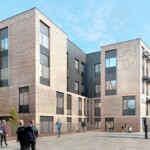Edinburgh’s infrastructure: the 10-year city mobility plan guide, Property Advice, Tips
Edinburgh’s Infrastructure: The 10-Year City Mobility Plan
22 Feb 2021
Edinburgh’s historic city has published a 10-year plan; the goal is to deliver a better connected, zero-carbon transport system and, in turn, a healthier environment and more inclusive capital city.
Alongside the adopted 2016 local development plan and the City Plan 2030, the City Mobility Plan champions 20-minute neighbourhoods. This concept aims to have local services within a 20-minute walk of a city resident’s home or business. The Mobility Plan goes even further to envision neighbourhoods where people’s needs are met within a 10-minute walk or cycle from their home.
When approved, the new plan will replace Edinburgh’s Local Transport Strategy agreed in 2016 and set out a strategic approach to the ‘sustainable and effective’ movement of people and goods around the city over the next decade. Proving that Edinburgh is a beautiful place to visit is a modern, forward-thinking ‘Smart City’ that cares about Scotland and, in turn, the world.
Edinburgh’s Infrastructure – 10-Year City Mobility Plan News
Forward-thinking World Cities
In a statement by the transport and environment convener, the council said the City Mobility Plan had been inspired by other forward-thinking or smart cities worldwide, embracing challenges to tackle climate change with net-zero targets and, in turn, tackle poverty and inequality.
According to a recent article by ASME (the American Society of Mechanical Engineers), Edinburgh will join the list of the top cities in the world who are proud to say they have adopted “smart city” principles, and the list includes the following early instigators:
- Singapore
- Dubai
- Oslo
- Copenhagen
- Boston
- Amsterdam
- New York
- London
- Barcelona
- Hong Kong
Practical Change in Edinburgh
Among the measures included is the commitment to encourage a change in public behaviour towards sustainable transport, expanding the tram and a mass rapid transit network and improvements to the current routes. Implementing an updated mobility hub in existing communities, new developments and connecting the two while introducing a city operations centre to monitor traffic and review results are also part of the plan.
The plan also promises to create more people-friendly places less dominated by traffic and build on the walking and cycling routes. The strategy follows many years of engagement with the public, stakeholders and relevant partners. This includes a consultation that happened last year, which gathered more than 1,800 comments on the draft proposals with support outlined for all policy measures. A similar consultation-based strategy was used with the Haymarket Redevelopment and helped narrow down the development options.
Changes as a result of COVID-19
Policy measures centre around three significant themes. These are people, place and movement between factors. The criteria also acknowledge the impact the pandemic has had on the current transport demands and mobility. Taking into account how a green recovery can harness lower traffic levels and their associated effects.
Miles Stones to 2030
The committee has set out a path to 2030 and an implementation plan for policy measures delivered in short to long term. By 2022 Measures include:
- Tram route to Newhaven, which is on course to being completed
- A review of bus routes in the city
- The current generation of active travel schemes delivered
- The Low Emissions Zone will be active
- The investment plan for the resources generated in public transport improvements by the workplace parking levy will be finalised
- Working with Transport Scotland and Network Rail, the Waverley station masterplan will have a complete implementation plan
2025 – Measures Include:
An all-encompassing transit plan for the city and regions will be complete as quickly as possible. Measures will include new bus and tram systems and park and ride along with the edge of city logistics hubs. The committee will agree upon the case for a north-south tram line to link Granton to the Bio Quarter and beyond.
A comprehensive new bus strategy will be agreed upon, including stops, routes, and public transport interchanges. Bus congestion will be reduced, and bus placement of key streets like Princes Street will be addressed, and George Street will be transformed as a consequence.
Another result will be that air pollution levels will be significantly reduced following introducing a low emission zone around the city centre and the city boundary.
A technology-driven approach to mobility needs will be in place, working with the taxi trade, public transport providers and the commercial sector.
Conditions for pedestrians will improve, thanks to the delivery of the Edinburgh street design guidance policy and enforcement of the rules.
2030 – Edinburgh Transformed
Planning allows for changes to the mass transit network, including the tram. Routes will be extended west to Newbridge and developed to connect the city’s Waterfront north to the south’s Royal Infirmary. The city region’s seven park and ride facilities will be upgraded to support fast and frequent public transport along these well thought out bus lanes promoting extensive rapid transit routes from these pickup points into the centre.
The arterial routes will be used for mass commuting by bike. The city centre will be mainly car-free, with the workplace parking levy reducing revenue as cars’ use to commute declines.
Finally, the iconic streets will be progressively pedestrianised to encourage tourism while swerving the community and promoting change globally.
Comments on this Edinburgh’s infrastructure: the 10-year city mobility plan article are welcome.
Edinburgh Architecture
New National Centre For Music Edinburgh
Comments / photos for the Edinburgh’s infrastructure: the 10-year city mobility plan Advice page welcome.




